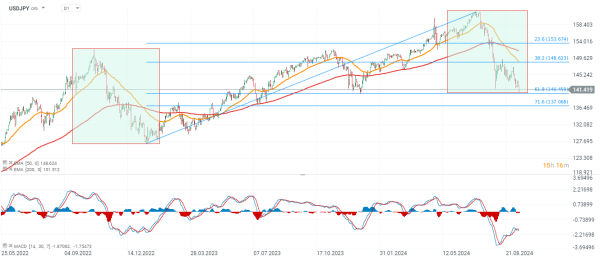USDJPY sinks 0.7% below August 5 panic as BoJ Nakagawa opens a path for rate hikes 📉
The USDJPY pair dropped today to the lowest level since Dec. 28 2023, as BoJ participants expressed that further rate hikes are the basic scenario as Japanese economy upward momentum persists. However, Junko Nakagawa commented that it's hard to predict the term of the next BoJ rate hike. Further strengthening of Japanese Yen, with falling US dollar pressure 'carry trade', with multiple hedge funds such as Telemetry seeing rising risk of changing financial market conditions. Nakagawa expects, that still too high inflation overseas will put inflationary pressure on Japanese import prices (while stronger yen pressures Japanese exporters), while inflation is on track to rise, with stronger domestic demand across the consumers.
- Rising import prices could affect consumer inflation with a lag
- Wage growth likely to accelerate as a trend, reflecting rising prices and stronger domestic demand
- Consumption likely to increase moderately, reflecting wages momentum,
- Expect inflation to gradually accelerate as a trend. Achievement of wage-inflation cycle is still in sight
- Upside risk to inflation persists, while downside risks may come from slowdown in global economies
- Even after July rate hike, real interest rates remain deeply negative, monetary conditions are accomodative
- Prices move in line with the BoJ projection, signalling reasonable adjustment in the monetary policy easing
- Japan fundamentals are still strong and record profits at Japan firms are not in risk
- Further real-estate market prices increases may support BoJ rate hike faster, even this year
Consumer inflation in Japan came in 2.7% in July (at or above 2% BoJ target for 28 consecutive months). The real interest rates are still very low, while traders expect that August USDJPY slump will probably not stop Bank of Japan, out of the 'sea change' in interest rates. Nakagawa remarks support this thesis, while final BoJ policy outcome is still uncertain, with recession risk in US, Europe and slowing demand China, which can may pressure Japanese companies and economic conditions.
USDJPY (D1 interval)
USDJPY erased some declines, dropping 0.7% today, after reaching 140.6 level earlier today. The volatility may increase during the US CPI reading at 1:30 PM BST. Declines stopped in the 140.5 zone, at 61.8 Fibonacci retracement of the upward wave, since 2022. The scale of current declines may signal 1:1 correction (green zones on the chart) in the long term, upward trend if the pair will rebound from current levels. Eventually higher than expected US CPI report may support at least short term rebound, while downside 'trend-changing' risk persists.
 Source: xStation5
Source: xStation5